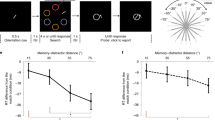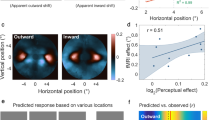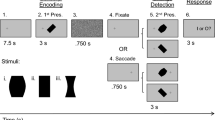Abstract
Functional magnetic resonance imaging (fMRI) of subjects attempting to detect a visual change occurring during a screen flicker was used to distinguish the neural correlates of change detection from those of change blindness. Change detection resulted in enhanced activity in the parietal and right dorsolateral prefrontal cortex as well as category-selective regions of the extrastriate visual cortex (for example, fusiform gyrus for changing faces). Although change blindness resulted in some extrastriate activity, the dorsal activations were clearly absent. These results demonstrate the importance of parietal and dorsolateral frontal activations for conscious detection of changes in properties coded in the ventral visual pathway, and thus suggest a key involvement of dorsal–ventral interactions in visual awareness.
This is a preview of subscription content, access via your institution
Access options
Subscribe to this journal
Receive 12 print issues and online access
$209.00 per year
only $17.42 per issue
Buy this article
- Purchase on Springer Link
- Instant access to full article PDF
Prices may be subject to local taxes which are calculated during checkout





Similar content being viewed by others
References
Rensink, R. A., O'Regan, J. K. & Clark, J. J. To see or not to see: the need for attention to perceive changes in scenes. Psychol. Sci. 8, 368–373 (1997).
O'Regan, J. K., Rensink, R. A. & Clark, J. J. Change-blindness as a result of 'mudsplashes.' Nature 398, 34 (1999).
Navon, D. & Gofer, D. On the economy of the human processing system. Psychol. Rev. 80, 214–255 (1979).
Kanwisher, K., McDermott, J. & Chun, M. M. The fusiform face area: a module in human extrastriate cortex specialized for face perception. J. Neurosci. 17, 4302–4311 (1997).
Gorno Tempini, M. L. et al. The neural systems sustaining face and proper-name processing. Brain 121, 2103–2118 (1998).
Epstein, R. & Kanwisher, K. A cortical representation of the local visual environment. Nature 392, 598–601 (1998).
Milner, D. & Goodale, M. The Visual Brain in Action (Oxford Univ. Press, Oxford, 1995).
Ro, T., Russell, C. & Lavie, N. Changing faces: a detection advantage in the flicker paradigm. Psychol. Sci. 12, 94–99 (2001).
Tong, F., Nakayama, K., Vaughan, J. T. & Kanwisher, K. Binocular rivalry and visual awareness in human extrastriate cortex. Neuron 21, 753–759 (1998).
Grill-Spector, K., Kushnir, T., Hendler, T. & Malach, R. The dynamics of object-selective activation correlate with recognition performance in humans. Nat. Neurosci. 3, 837–843 (2000).
Logothetis, N. Object vision and visual awareness. Curr. Opin. Neurobiol. 8, 536–544 (1998).
Zeki, S. A Vision of the Brain (Blackwell Scientific Publications, Oxford, 1993).
Farah, M. J. Visual Agnosia: Disorders of Object Recognition and What They Tell Us About Normal Vision (MIT Press, Cambridge, Massachusetts, 1990).
Driver, J. & Mattingley, J. B. Parietal neglect and visual awareness. Nat. Neurosci. 1, 17–22 (1998).
Rees, G. et al. Unconscious activation of visual cortex in the damaged right hemisphere of a parietal patient with extinction. Brain 123, 1624–1633 (2000).
Lumer, E. D., Friston, K. J. & Rees, G. Neural correlates of perceptual rivalry in the human brain. Science 280, 1930–1934 (1998).
Kleinschmidt, A., Büchel, C., Zeki, S. & Frackowiak, R. S. J. Human brain activity during spontaneously reversing perception of ambiguous figures. Proc. R. Soc. Lond. B Biol. Sci. 265, 2427–2433 (1998).
Shulman, G. L., Ollinger, J. M., Linenweber, M., Peterson, S. E. & Corbetta, M. Multiple neural correlates of detection in the human brain. Proc. Natl. Acad. Sci. USA 98, 313–318 (2001).
Corbetta, M., Miezen, F. M., Dobmeyer, S., Shulman, G. L. & Peterson, S. E. Selective and divided attention during visual discriminations of shape, color, and speed: functional anatomy by positron emission tomography. J. Neurosci. 11, 2383–2402 (1991).
Coull, J. T. & Frith, C. D. Differential activation of right superior parietal cortex and interparietal sulcus by spatial and nonspatial attention. Neuroimage 8, 176–187 (1998).
Treue, S. & Maunsell, J. H. R. Attentional modulation of visual motion processing in cortical areas MT and MST. Nature 382, 539–541 (1996).
O'Craven, K. M., Rosen, B. R., Kwong, K. K., Treisman, A. & Savoy, R. L. Voluntary attention modulates fMRI activity in human MT-MST. Neuron 18, 591–598 (1997).
Rees, G., Frith, C.D. & Lavie, N. Modulating irrelevant motion perception by varying attentional load in an unrelated task. Science 278, 1616–1619 (1997).
Mack, A. & Rock, I. Inattentional Blindness (MIT Press, Cambridge, Massachusetts, 1998).
Rees, G., Russell, C., Frith, C. D. & Driver, J. Inattentional blindness versus inattentional amnesia for fixated but ignored words. Science 286, 2504–2507 (1999).
Simons, D. J. & Levin, D. T. Failure to detect changes to people during a real-world interaction. Psychon. Bull. Rev. 5, 644–649 (1998).
Gitelman, D. R., Parrish, T. B., LaBar, K. S. & Mesulam, M. -M. Real-time monitoring of eye movements using infrared video-oculography during functional magnetic resonance imaging of the frontal eye fields. Neuroimage 11, 58–65 (2000).
Friston, K. J. et al. Statistical parametric maps in functional imaging: a general linear approach. Hum. Brain Mapp. 2, 189–210 (1995).
Turner, R., Howseman, A., Rees, G. E., Josephs, O. & Friston, K. J. Functional magnetic resonance imaging of the human brain: data acquisition and analysis. Exp. Brain Res. 123, 5–12 (1998).
Acknowledgements
We thank N. Kanwisher for providing the face and place images, and J. Driver for his comments on the manuscript. This work was supported by a Biotechnology and Biological Sciences Research Council grant (N.L.), a Medical Research Council career award (N.L.) and The Wellcome Trust (G.R., C.F.).
Author information
Authors and Affiliations
Corresponding author
Rights and permissions
About this article
Cite this article
Beck, D., Rees, G., Frith, C. et al. Neural correlates of change detection and change blindness. Nat Neurosci 4, 645–650 (2001). https://doi.org/10.1038/88477
Received:
Accepted:
Issue Date:
DOI: https://doi.org/10.1038/88477
This article is cited by
-
Attention modulates neural representation to render reconstructions according to subjective appearance
Communications Biology (2022)
-
Informative neural representations of unseen contents during higher-order processing in human brains and deep artificial networks
Nature Human Behaviour (2022)
-
The critical role of phase difference in theta oscillation between bilateral parietal cortices for visuospatial working memory
Scientific Reports (2018)
-
Missing the Target: the Neural Processing Underlying the Omission Error
Brain Topography (2017)



